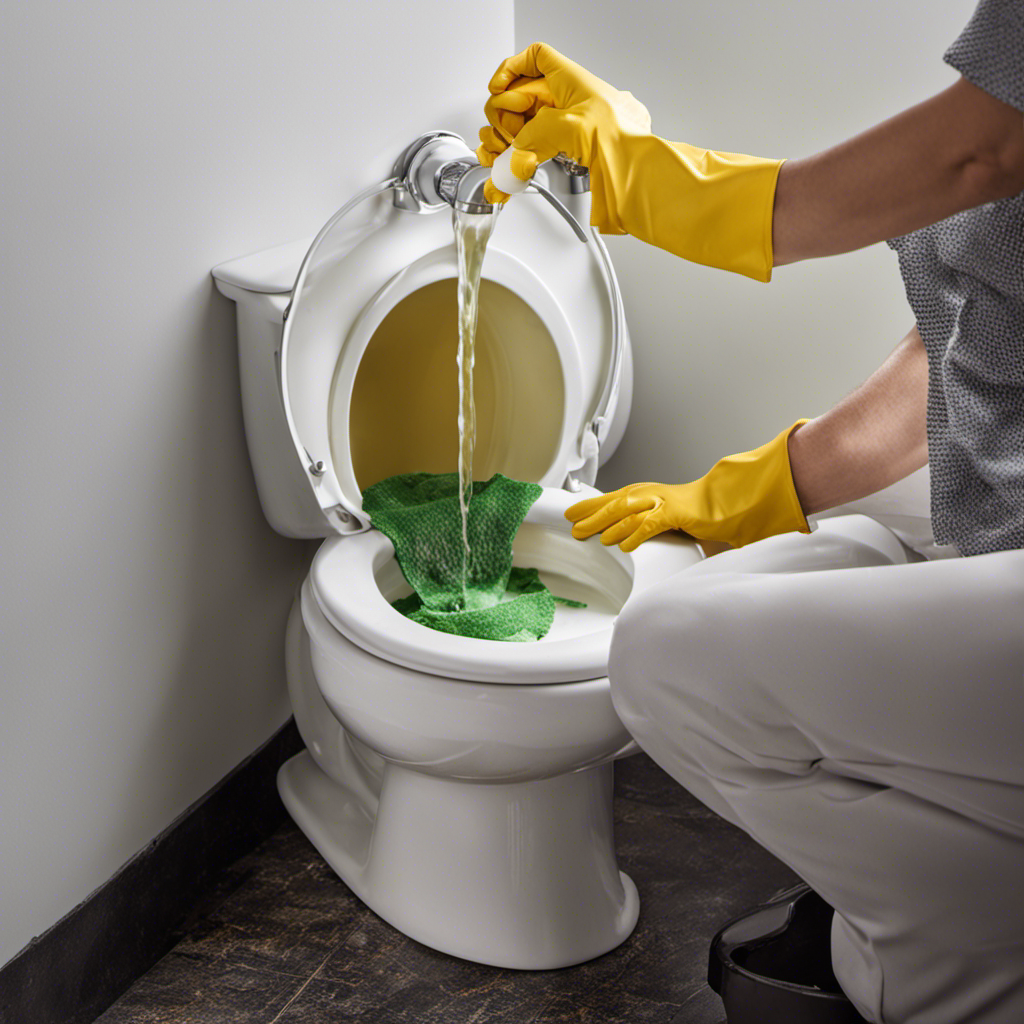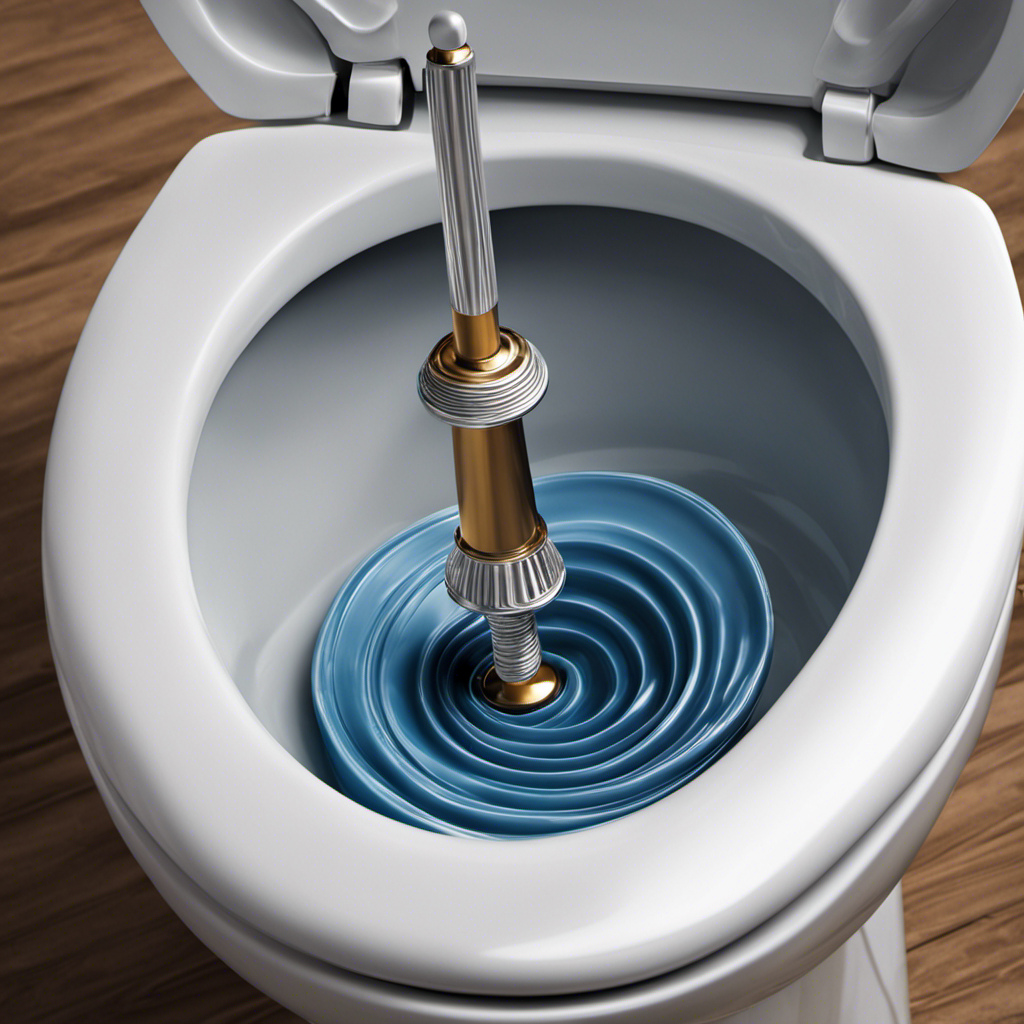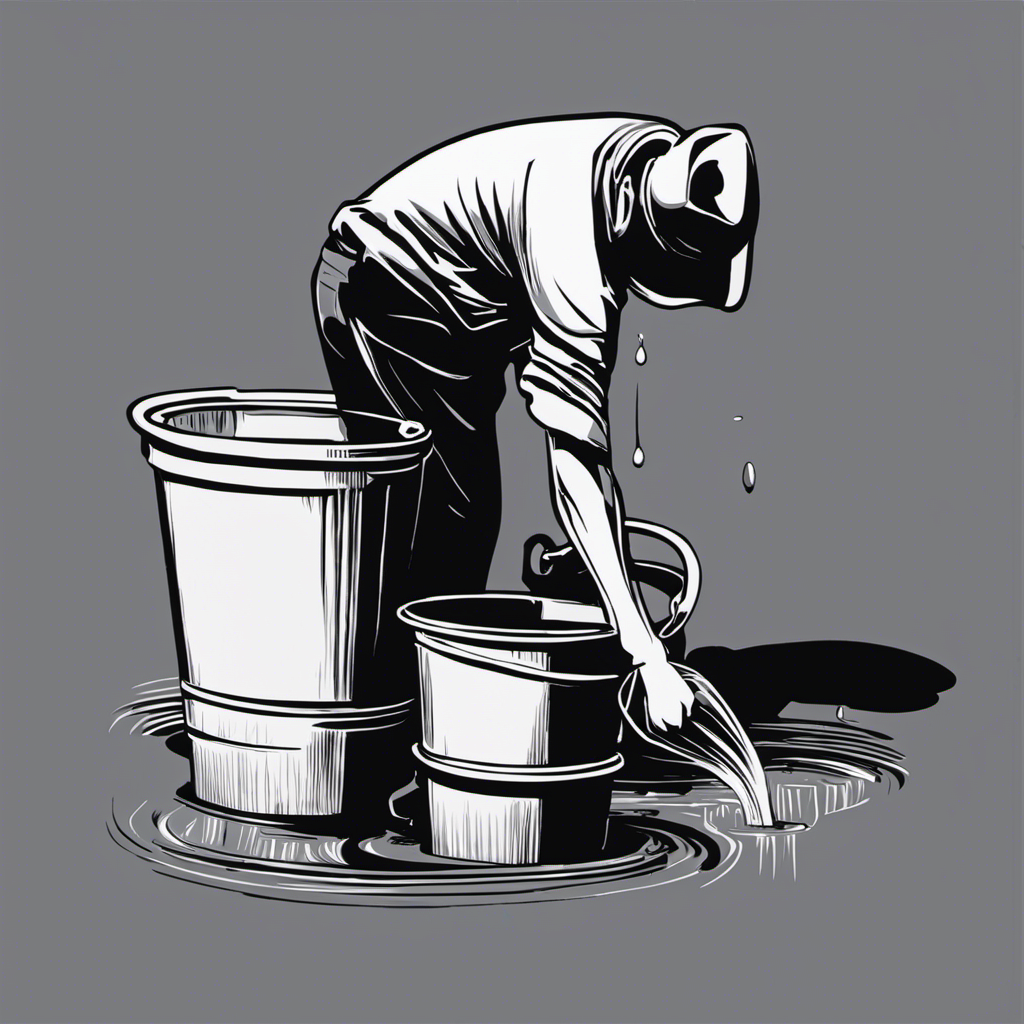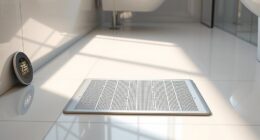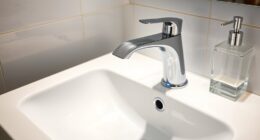I’ve been there – standing in front of a clogged toilet with no plunger in sight. It’s a frustrating situation that can leave you feeling helpless.
But fear not, there is a way to tackle this problem without the traditional tool. In this article, I will guide you through the step-by-step process of unclogging your toilet using common household items and natural methods.
Say goodbye to the panic and hello to a clear, functioning toilet once again.
Key Takeaways
- Baking soda and vinegar can be used to unclog a toilet without a plunger.
- Hot water and dish soap can also be effective in clearing a clog.
- Using a wire hanger or toilet snake can help dislodge the blockage.
- Regular maintenance and preventive measures can help minimize the risk of future clogs.
Common Household Items for Toilet Unclogging
One of the most effective and convenient ways to unclog a toilet without a plunger is by using common household items you already have. There are several toilet plunger alternatives and DIY toilet unclogging methods that can save you from the hassle of using a plunger.
One option is to use a mixture of baking soda and vinegar. Simply pour half a cup of baking soda into the toilet bowl, followed by one cup of vinegar. Let the mixture sit for a few minutes, and then flush the toilet.
Another option is to use a wire hanger. Straighten out the hanger and create a hook at one end. Insert the hooked end into the toilet drain and gently push and pull to dislodge the clog.
These alternatives can be quick and effective solutions for unclogging your toilet without a plunger.
Now, let’s move on to a step-by-step guide to unclog a toilet.
Step-by-Step Guide to Unclog a Toilet
When it comes to unclogging a toilet, there are alternative methods that can be just as effective as using a plunger. These methods include using a toilet auger or a mixture of baking soda and vinegar.
Additionally, it is important to take preventive measures to avoid future toilet clogs. This can be done by avoiding flushing non-flushable items and regularly maintaining the plumbing system.
Alternative Unclogging Methods
There are several alternative methods to unclog a toilet without using a plunger. Here are three effective options:
-
Toilet Snake: A toilet snake, also known as a plumbing snake or auger, is a long, flexible tool designed to dislodge clogs in pipes. Insert the snake into the toilet drain and rotate the handle to break up the blockage. Pull out the snake slowly to remove the clog.
-
Hot Water and Dish Soap: Pouring hot water mixed with dish soap into the toilet bowl can help break down the clog. Let the mixture sit for a few minutes, then flush the toilet to see if the water drains properly.
-
Baking Soda and Vinegar: Mix equal parts baking soda and vinegar and pour the mixture into the toilet bowl. Let it sit for a few hours or overnight, then flush the toilet. The chemical reaction between the baking soda and vinegar can help dissolve the clog.
Preventing Future Toilet Clogs
To prevent future toilet clogs, it’s important to be mindful of what you flush down the toilet. Proper toilet maintenance and understanding toilet flush frequency are key to avoiding clogs.
First, ensure that only human waste and toilet paper are flushed down the toilet. Avoid flushing items such as sanitary products, wipes, or excessive amounts of toilet paper, as they can easily cause clogs.
Additionally, be aware of how often you flush the toilet. Flushing too frequently can overwhelm the plumbing system and increase the likelihood of clogs.
By practicing good toilet habits and being conscious of what you flush, you can minimize the risk of future clogs and keep your toilet functioning properly.
Now, let’s explore some natural methods for clearing a clogged toilet.
Natural Methods for Clearing a Clogged Toilet
When it comes to clearing a clogged toilet, there are several natural methods that can be effective.
One option is to use a combination of vinegar and baking soda, which creates a chemical reaction that helps break up the clog.
Another method involves pouring hot water mixed with dish soap into the toilet bowl to loosen the obstruction.
Lastly, using a toilet auger tool can be a more hands-on approach to physically remove the blockage.
Vinegar and Baking Soda
Mix vinegar and baking soda together in a bowl to create a powerful solution for unclogging your toilet. This is one of the most effective natural remedies for dealing with a clogged toilet.
Here are three reasons why you should consider using vinegar and baking soda as a DIY solution:
-
Chemical reaction: When vinegar and baking soda are combined, they create a fizzy reaction that helps break down the blockage in your toilet. This chemical reaction helps to dissolve the clog and clear the pipes.
-
Safe and non-toxic: Unlike chemical drain cleaners, vinegar and baking soda are safe and non-toxic. They won’t harm your plumbing system or pose any health risks to you or your family.
-
Cost-effective: Vinegar and baking soda are readily available in most households, making them a cost-effective solution for unclogging your toilet. You don’t need to spend money on expensive drain cleaners or plumbing services.
Hot Water and Dish Soap
Using hot water and dish soap is an alternative method for unclogging your toilet. It can be an effective solution when you don’t have a plunger or want to avoid using harsh chemicals. However, it’s important to follow some safety precautions when using hot water. Make sure the water is not boiling, as it can crack the toilet bowl. Use water that is as hot as you can tolerate. To enhance the effectiveness of the hot water, add a few squirts of dish soap to create a slippery solution that can break down the clog. The soap helps to lubricate the pipes and allows the water to flow more easily, aiding in unclogging the toilet. But remember, this method may not work for all types of clogs, so if the problem persists, it’s best to call a professional plumber.
| Pros | Cons |
|---|---|
| 1. Safe and non-toxic | 1. May not work for all clogs |
| 2. Easily accessible | 2. Requires hot water |
| 3. Can be effective | 3. Requires dish soap |
Toilet Auger Tool
After attempting the hot water and dish soap method without success, I decided to try using a toilet auger tool. A toilet auger is a specialized tool designed to unclog toilets by breaking up and removing blockages. Here are some benefits of using a toilet auger:
-
Effective unclogging: A toilet auger is specifically designed to tackle stubborn clogs that other methods may not be able to handle. It has a long, flexible cable with a coiled end that can navigate through the toilet trap and break up the blockage.
-
No mess: Unlike using a plunger, which can create a messy splashback, a toilet auger allows you to work directly on the clog without causing any unnecessary mess or water spillage.
-
Versatility: A toilet auger can be used as a substitute for a plunger in situations where a plunger is not available or not effective. It is a reliable tool that can quickly resolve toilet clogs and restore proper flushing functionality.
Using a toilet auger can be a handy and efficient solution when dealing with a stubborn toilet clog.
Alternative Tools for Toilet Unplugging
There’s a handy tool called a toilet snake that can help unclog your toilet without a plunger. A toilet snake, also known as a drain auger, is a long, flexible metal cable with a coiled end. It is designed to break up and remove stubborn clogs in your toilet’s plumbing.
To use a toilet snake, you insert the coiled end into the toilet bowl and slowly twist the handle, feeding the cable into the drain. As you continue to twist, the coiled end will grab onto and break up the clog, allowing the water to flow freely again.
If the clog is caused by organic matter, such as toilet paper or waste, you can also try using an enzyme cleaner along with the toilet snake. The enzyme cleaner contains natural enzymes that break down organic material, making it easier for the snake to remove the clog.
Quick Fixes for a Clogged Toilet
If your toilet is clogged, a quick fix is to pour hot water into the bowl and let it sit for a few minutes. This method can help loosen the blockage and allow it to flow through the pipes more easily.
Here are three DIY toilet unclogging methods that you can try before resorting to a plunger:
-
Baking Soda and Vinegar: Mix half a cup of baking soda with half a cup of vinegar and pour it into the bowl. Let it sit for about 20 minutes before flushing. The chemical reaction between the two ingredients can help break down the clog.
-
Dish Soap and Hot Water: Squirt a generous amount of dish soap into the toilet bowl, followed by hot water. Let it sit for a few minutes, then flush. The soap acts as a lubricant and the hot water helps to dissolve the blockage.
-
Wire Hanger: Straighten out a wire hanger and create a hook at one end. Insert the hook into the toilet and gently maneuver it around to break up the clog. Be careful not to scratch the porcelain.
By trying these toilet plunging alternatives, you may be able to unclog your toilet without the need for a plunger. However, if these methods don’t work, it may be time to consider using a plunger or seeking professional help.
Now, let’s discuss some preventive measures to avoid toilet clogs.
Preventive Measures to Avoid Toilet Clogs
To prevent clogs in your toilet, you should regularly maintain and clean the pipes. Proper toilet maintenance and implementing effective clog prevention techniques can help avoid unnecessary headaches and costly repairs. Here are some key preventive measures to keep your toilet running smoothly:
| Technique | Description | Frequency |
|---|---|---|
| Regular cleaning | Use a toilet brush and cleaner to remove any buildup and debris from the bowl and rim. | Weekly |
| Flushing restrictions | Avoid flushing anything other than toilet paper and human waste to prevent blockages. | Always |
| Regular inspections | Check the flushing mechanism, water level, and fill valve regularly to ensure proper functioning. | Monthly |
| Proper waste disposal | Avoid disposing of items such as diapers, wipes, or sanitary products in the toilet. | Always |
| Plumbing maintenance | Schedule professional plumbing inspections and maintenance to identify and fix any issues. | Annually |
Conclusion
In conclusion, unclogging a toilet without a plunger is a simple task that can be accomplished using common household items and natural methods. By following the step-by-step guide provided, anyone can clear a clogged toilet efficiently and effectively.
Additionally, alternative tools can be used in case a plunger is not available. Remember, quick fixes can be handy in emergency situations, but it is important to take preventive measures to avoid future toilet clogs.
With these techniques, you’ll be able to tackle even the toughest clogs with ease, making your bathroom experience a breeze.
